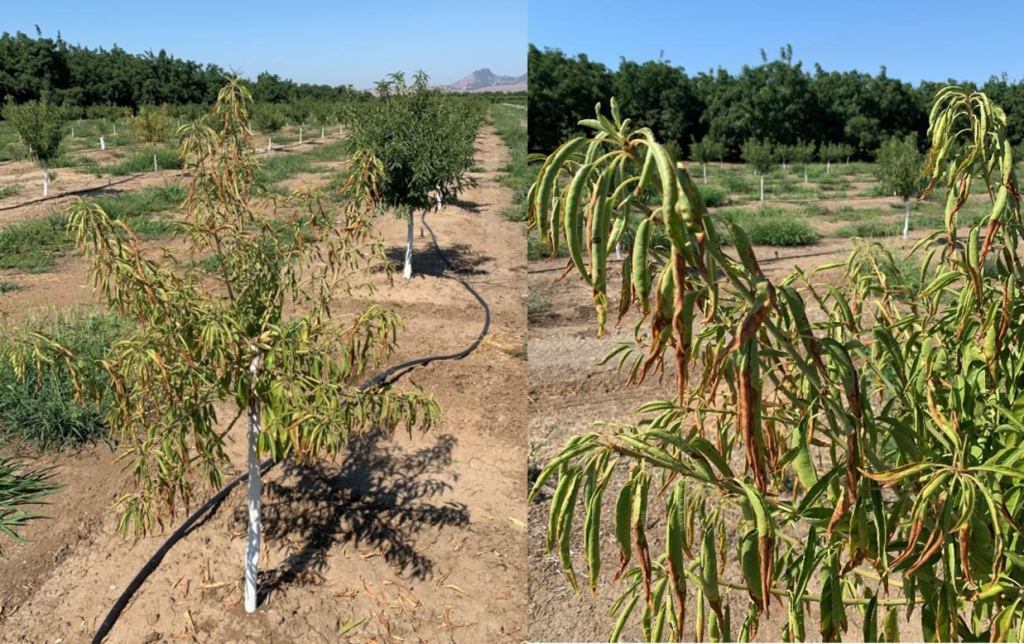Luke Milliron, UCCE Orchard Advisor; Butte, Glenn, and Tehama Counties
Franz Niederholzer, UCCE Farm Advisor; Colusa, Sutter/Yuba Counties
Katherine Jarvis-Shean, UCCE Orchard Advisor; Sacramento, Solano, and Yolo Counties
Clarissa Reyes, UCCE Orchard Advisor; Sutter-Yuba, Butte, and Placer Counties
Evie Smith, Former UCCE Staff Research Associate; Southern Sacramento Valley
Almond variety and rootstock selection is a quarter century investment. After choosing which crop type to plant, this is likely the most important decision you will make when planting a new orchard. The difference in results is massive. A poor selection could lead to the orchard failing to establish and needing to be removed or providing sub-standard yield for the life of the orchard. A successful selection could mean your trees are regularly yielding twice as much as a different variety-rootstock combination.
Variety and rootstock selections are typically thought of separately. Each rootstock is bred or selected to have different strengths and adaptations for different soil types, irrigation volumes, levels of anchorage, and ability to withstand adverse field conditions like nematodes, soil-borne pathogens, and toxic elements. Varieties are selected with self-fertility, pollen-compatibility and timing, marketing classification and price, quality and consistency, disease susceptibility, yield, and other factors in mind. However, evaluating the compatibility of different varieties and rootstocks together is critical to deciding whether a combination will be successful. A well-known nurseryman once said, “It takes 20 years to prove a rootstock”. We would add that it takes even longer to prove a variety, and a variety-rootstock combination. Why is the process as much as 30-40 years to provide growers with a winning variety-rootstock? Regional variety trials take the first 15-20 years but are only testing in three locations across the Central Valley and on only one rootstock per location. Once early adopters then plant the new variety-rootstock combination they become the researcher for another 20 plus years. If the grower decides to plant the same variety-rootstock combination for a second-generation orchard, we know we truly have a winner!
In the Sacramento Valley, Krymsk®86, a hybrid of peach and Myrobalan plum parentage, is enormously popular due to rock-solid anchorage and a relatively higher tolerance of “wet feet” (flooding or soil saturation) compared to peach seedling rootstocks such as Lovell and Nemaguard. Krymsk® 86 rootstock has only been widely planted for about 15 years: while it consistently lives up to its promise of strong anchorage and strong production potential with many varieties, especially Nonpareil, we are still learning about how it performs with other varieties in different field conditions. In wet springs, Monterey and Butte on Krymsk® 86 rootstocks have demonstrated a higher tendency to have slow, yellow growth, a disorder termed ‘Yellow Curling Leaf’ (YCL). YCL symptoms have also been observed in Monterey on Rootpac®-R (almond x plum) rootstock. Trees with YCL express foliar symptoms similar to the Union Mild Etch (UME) disorder affecting those same varieties and others on the Marianna 2624 plum rootstock with typical symptoms including poor tree growth and yellowing leaves that roll and produce necrotic margins. YCL like UME, occurs mostly in second leaf orchards, although both disorders have been observed on older trees. UME was clearly linked to excess soil moisture in the root zone in wet springs or with over-irrigation resulting in excess soil moisture in late spring/early summer. Under those conditions weak pathogens attacked the small feeder roots, affecting growth, but rarely killing the trees. Affected Krymsk® 86 rooted trees, like those on Marianna 2624 usually recover over time when excessive soil moisture is corrected.
More recently, some new self-fertile varieties have performed very poorly in the Sacramento Valley when grafted to Krymsk® 86. YCL symptoms for example have shown up in multiple seasons in some orchards – leading to a stunted orchard and the decision by the grower to remove the orchard entirely. Other orchards were removed early in the 2023 season after suffering massive tree losses due to suspected bacterial canker. Our current thinking is that like the UME issues on Marianna rootstock – the problems we are now seeing with certain varieties on Krymsk® 86 may have to do with the plum parentage of Krymsk® 86. Without testing each new variety that breeders produce on Krymsk® 86 over many years, we won’t know which varieties are more likely to have severe problems.

Low vigor and yellow curled leaf (YCL) symptoms on 2nd leaf Independence® on Krymsk® 86 rootstock. Photos taken July 2, 2021. Photo Credit: Franz Niederholzer.
Do you have a new variety struggling on Krymsk® 86?
- Use the pressure chamber and soil moisture monitoring to avoid over-irrigation, which can exacerbate YCL symptoms.
- Some growers have had success bypassing the rootstock and providing nutrition with foliar applications. However, this is very expensive, unsustainable, and doesn’t correct the fundamental problem for providing long-term nutrition.
- Have ongoing discussions with your nurseryman, PCA, and farm advisor.
For future orchards using a new variety:
- If you have historic almond orchard performance, start your variety selection process with what has performed best previously. Your local farm advisor is a great resource for these variety and rootstock selection conversations.
- Talk with your processor about what varieties the market wants now and what future trends could look like.
- Consider rootstocks other than Krymsk® 86 (article and comparison tool / podcast). Self-fertile trees planted on other standard rootstocks without significant plum parentage (e.g. Viking and Atlas) or the more vigorous peach-almond hybrid rootstocks (e.g. Hansen 536, Brights, Nickels, and Titan) have not exhibited the same symptoms as those seen on Krymsk® 86 in the Sacramento Valley.
- Stay tuned for developments at the UC Butte County almond variety trials (all varieties on Krymsk® 86 rootstock, planted at the CSU Chico University Farm) to help inform your decisions about new almond varieties.


Leave a Reply